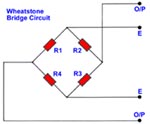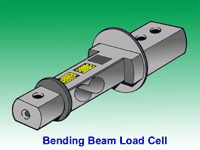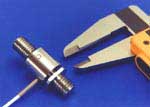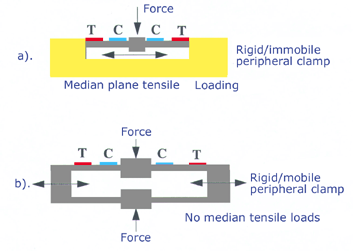|
LOAD
/ FORCE CELLS

The load
or force cell takes many forms to accommodate the variety of
uses throughout research and industrial applications. The majority
of today's designs use strain gauges as the sensing element,
whether foil or semiconductor.
Foil gauges
offer the largest choice of different types and in consequence
tend to be the most used in load cell designs. Strain gauge patterns
offer measurement of tension, compression and shear forces.
Semiconductor
strain gauges come in a smaller range of patterns but offer the
advantages of being extremely small and have large gauge factors,
resulting in much larger outputs for the same given stress. Due
to these properties, they tend to be used for the miniature load
cell designs.
Proving rings
are used for load measurement, using a calibrated metal ring,
the movement of which is measured with a precision displacement
transducer.
A vast number
of load cell types have developed over the years, the first designs
simply using a strain gauge to measure the direct stress which
is introduced into a metal element when it is subjected to a
tensile or compressive force. A bending beam type design uses
strain gauges to monitor the stress in the sensing element when
subjected to a bending force.

More recently
the measurement of shear stress has been adopted as a more efficient
method of load determination as it is less dependent on the way
and direction in which the force is applied to the load cell.
The 'S'
or 'Z' Beam Load Cell


A simple design
load cell where the structure is shaped as a 'S' or 'Z' and strain
gauges are bonded to the central sensing area in the form of
a full Wheatstone bridge.
The Wheatstone Bridge Circuit

E = Excitation
Voltage(typically 10 Vdc.)
O/P = Output Signal
The Bending
Beam Load Cell


The strain
gauges are bonded on the flat upper and lower sections of the
load cell at points of maximum strain. This load cell type is
used for low capacities and performs with good linearity. Its
disadvantage is that it must be loaded correctly to obtain consistant
results.
The Shear Beam Load Cell


The strain
gauges are bonded to a reduced part of the cross section of the
beam in order to maximise the shear effect. They are bonded at
45 degree angles on either side of the beam to measure the shear
strains.

Used for medium
to large capacities, the load cell has good linearity and is
not so susceptible to extraneous loading, in particular to side
loads.

Miniature
Load Cells


Miniature load
cells because of their compact size usually use semiconductor
strain gauges as the sensing element. They are available in many
different configurations for both tension and compression force
measurement. They offer good performance with high outputs and
high overload capabilty for protection.
Speciality
Automotive/Autosport Load Cells

Many more
Load Cell designs exist and we will bring you details
of these at a later stage.
LOAD CELL SPRING MEMBER DESIGN
CONSIDERATIONS
Bending: Simple

FIGURE
1. Bending: The simple cantilever
|
Bending elements
are low-force, generally less than 1,000 lbf range,
high-deflection structures offering convenient and flat strain
gauging surfaces where complete push/pull strain symmetry is
maintained.
Two strain gauges may be mounted on the top surface of the beam
with two strain gauges mounted on the bottom of the beam in equal
and opposite strain fields. Since strain gauges are directly
opposite one another and beam thickness tends to be small, little
likelihood exists that the strain gauges will operate at different
temperatures providing generally good thermal performance. Although
the cantilever beam structure provides excellent electrical nonlinearity,
due to electrical symmetry, the point of load contact with the
beam translates curvilinearly, producing mechanical nonlinearities.
The maximum moment resisting movement of the beam occurs at the
rigid clamp with the maximum stress occurring according to My/IE
where M= moment at the clamp, y = displacement from the centerline
of the beam (neutral axis), 1= area moment of Inertia and E =
Young's Modulus for the material used. Since the majority of
the beam length serves only to increase the moment at the rigid
clamp, various modifications of the simple beam are used to reduce
the beam mass in the interest of maintaining a high natural frequency
or to concentrate the strain at the strain gauge locations as
shown in Figure 2.
Lastly, a review of beam bending characteristics of reveals that
the surface strain present in the beam surface linearly varies
from the point of force application to the clamp. This implies
that the strain gauges will experience a strain gradient and
provide an output equating to the average strain.
Constant stress beam sections can be fabricated by tapering the
edges of the beam such that the tapered edges projected intersect
at the point of load application to the beam as shown in top
view Figure 2. In the end analysis, the load cell designer must
weigh the performance benefits produced against the cost of incorporating
the mechanical features shown.

FIGURE 2. Simple Cantilever Enhancements |
Bending:
Multiple
Multiple cantilever
structures produce a "multiple bending" where tension
and compression strain fields exist on the same surface of the
beam as shown in Figure 3a. The advantage of multiple bending
elements is realized when one considers that the point of load
application to the structure translates linearly along the loading
axis, thereby reducing or eliminating first order onlinearities.
When the peripheral support clamp is rigid and immobile, deflection
of the bending beams also produces median plane tensile loads
in the beam resulting in nonlinear outputs. When the peripheral
clamp is rigid and mobile, as shown in Figure 1, median plane
tensile stresses are eliminated however, as the beams deflect,
the moment arm reduces in length yielding yet another non-linear
term and doubling the deflection of the load cell. Note that
"T" is used in the Figure to denote tensile strains
and "C" is used to denote compressive strain.

FIGURE 3. Multiple Bending:
|
Multiple bending can be implemented as shown in Figure 4 where
the
sensitivity of the load cell to off-axis loads is minimized.
Coupled dual-beam load cell configurations conveniently produce
equal and opposite axial loads within each of the beams in response
to extraneous couples. Since the strain gauges can be wired to
cancel the effects of axial loads, the result is a load cell
structure largely insensitive to the point of load application
and articularly well-suited to commercial weighing applications.
As the beams deflect, however, small changes in the moment arm
lengths result producing geometric nonlinearities.
Additionally,
axial forces produce nonlinearities in each beam which tend to
be equal and opposing, thus canceling each other. Although strain
gauging inside a drilled hole is more labor intensive, the design
lends itself to effective sealing. Often vacuum degassed silicone
gel materials are used to fill the interior strain gaged cavity
waterproofing by the "exclusion" principle.
The "binocular"
dual beam design of Figure 4b is popular for low force commercial
weighing applications. The thickened sections resist bending
thereby reducing the compliance of the design and maximizing
the natural frequency. Note that the maximum strain occurs at
the transduction zones and is less than this value everywhere
else within the structure. Low-profile bending-based load cells
are usually configured as strain gaged diaphragms or multiple
strain-gaged spoke assemblies.
Often, low profile multiple-bending designs possess four spokes
at 90 degree intervals where strain gauges are wired to cancel
off-axis moment-induced strains. It should be noted; when in
the process of designing any load cell structure, the designer
must consider all bending as well as shear loads that the spring
element must communicate.

FIGURE 4. Coupled Dual-Beam Cantilevers:
Many of the
designs shown are depicted herein possessing right-angled corners.
To minimize stress concentrations that will occur at geometric
discontinuities, it is highly recommended that generous fillets
be used with particular attention to possible discontinuities
at surfaces tangent to radiused features. Stress risers will
often show local stresses in excess of the microyield strength
of the material used, producing zero instabilities and potential
fatigue failures.
Forty years ago sensor designers found that performance was almost
always enhanced when the sensor was fabricated from a solid billet
of material and attention paid to the elimination of structural
discontinuities. Today we have a much more refined understanding
of materials and material behavior along with the terminology
to express these various attributes and characteristics.
Bending:
Ring
The bending ring shown in Figure 5 has a rich history and is
popularly known as the Morehouse proving ring. The original design
having been appropriated from Russia. The Morehouse proving ring
was and continues to be used as a transfer standard in both sensor
calibration systems and materials test systems. It is obvious
from the design of the ring that each leg of the ring must communicate
axial loads while simultaneously experiencing bending. The fact
that both axial and bending occur within the transduction zone
of the sensor characterizes ring-style load cells.
The beauty of the proving ring with strain gauges installed as
shown is the fact that all gauges of the wheatstone bridge ideally
experience identical axial strain, resulting in cancellation
of axial strain effects in the output of the bridge. Another
attribute of the ring structure relates to the smoothly varying
tensile and compressive moment-induced strains that result due
to loading of the cell.
The original transduction method used with the structural ring
design predates strain gauges entirely where a manually "plucked"
metal reed and micrometer assembly were used to detect exceptionally
small deflections of the ring. A hardened ball bearing acts as
the micrometer-adjustable target surface against which the reed
tip oscillates, where the reed is also provided with a hardened
cylindrical tip, the micrometer is adjusted to move the target
until the reed just contacts the target, dampening the reed response.
The displacement sensitivity of this very mechanical system is
impressive. The output of the sensor is viewed directly on the
micrometer scale.
It should be noted that the design of the bosses communicating
load into the ring structure significantly affects the performance
of the ring. The optimum proportions and dimensions of these
bosses is as much determined by experience and test as it is
by rigorous mechanical design.
Bosses are often undercut or modified to be made more flexible
in the interest of rejecting off-axis loads trading off performance
for off-axis load rejection. Likewise, transduction zones are
provided with stress- concentrating notches to enhance output,
natural frequency and to reduce compliance. In some cases, the
extent to which these boss and flexure modifications extend are
so radical as to almost defy characterization as a ring-based
load cell. The single common thread in all of these designs is
the fact that transduction zones must communicate both bending
and axial loads.
FIGURE 5. Bending: The ring:

Shear:
Strain gauge-based
load cell structures, configured to operate based upon the measurement
of shear strain, provide high capacity and low compliance in
a compact and low profile geometry. Strain gauges measuring shear
are oriented at 45 degrees to the neutral axis in bending and
are mounted to straddle the neutral axis. Bending stresses are,
by definition, equal to zero at the neutral axis in bending.
Although the strain gauge must possess some finite physical dimensions,
by equally straddling the neutral axis in bending, half of each
strain gauge will experience some bending strain while the other
half will expenence the same strain in the opposite direction
thereby largely cancelling bending in the output of the sensor.
Practically, the shear patterns cannot be positioned with absolute
perfection and shear webs cannot be fabricated with absolute
symmetry resulting in less than perfect cancellation of bending
strains.
Unlike bending
stresses developed in the cantilever beam structure, where bending
stresses are a direct function of moment which itself is a direct
function of the moment arm, shear stresses by definition are
equal only to the load carried by the member and the area of
the member, independent of the point of loading. By varying the
thickness of the load-bearing member, the shear stresses are
varied in direct proportion. Utilizing this philosophy, load
carrying beams are often milled out to create shear "webs"
possessing an area sufficient to produce shear strains in the
1,000 to 1,700 microstrain range thereby yielding strain gage
full-bridge outputs of between 2 mV/V and 3 mV/V.
Shear strain gauge patterns are often used to strain gauge dual-axis
shear pin structures by gauging the inside diameter of a hole
drilled in a cylindrical member. The diameter of the internal
hole is dimensioned to result in a shear area sufficient to produce
the desired strains at rated input The central hole is readily
sealed, usually by welding of a hermetically sealed connector,
rendering the design useful in hostile environments.
In physically
realizable sensor structures, it is impossible to configure the
structure to experience pure shear without the presence of some
bending. The load bearing members must therefore communicate
both forms of material loading. Due to higher-order effects tending
to couple shear and bending strains, and in the interest of minimum
compliance, it is advisable to configure the spring member for
minimum bending. The reduction of spring member length will have
the effect of reducing moments and bending strains. The geometry
induces double bending where the inflection point is centered
on the shear web thereby minimizing the bending that results
at the strain gauge locations.
Figure
6. Shear:

The popular
"pancake" style load cell, as shown in Figure 6c, is
configured to operate in shear, offering a very low profile in
a design that is easily environmentally sealed and is largely
insensitive to off-axis loads. Generally, pancake style shear
web load cells are available in the 1,000 lbf and higher load
ranges.
The pancake style load cell also easily accommodates dual electrically
-separate strain bridges for high reliability applications. The
high stiffness "tension"-base serves to allow the measurement
of tensile forces, acts to stiffen the load cell structure in
compression and to allow the incorporation of overrange limiting
stops for compression applications. Low profile pancake load
cells are not available in the under 500 lbf force range since
the shear web thickness becomes exceedingly thin and difficult
to manufacture. It should be noted that the strain gage clamping
fixtures for the pancake style sensor either pinch the shear
webs to avoid overstressing them during manufacturing or all
cylindrical gaging holes shown are filled with teflon plugs which
provide clamping pressure due to volumetric expansion at elevated
epoxy cure temperatures. The teflon plugs used are closely-toleranced
to the diameter of the gauging holes and tend to extrude into
the hole-to-hole slots reducing the clamping pressure as a function
of he number of cure cycles they have been exposed to.

The design
section of this article was written by Mr. James Pierson
|

